
Je li fantastika sredstvo za razumijevanje stvarnosti, ili je možda obratno?
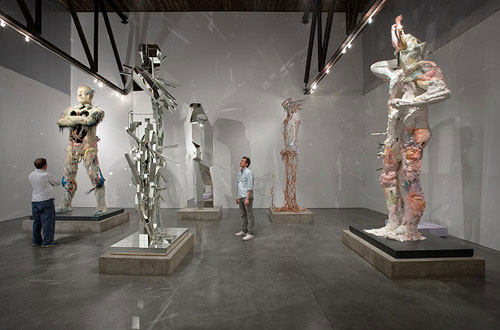
first image
‘david altmejd’ installation view at andrea rosen gallery (may 3 - june 14, 2008)
©david altmejd (photo by tom powel)
david altmejd burst onto the contemporary art scene
seemingly out of nowhere. the young sculptor began
exhibiting at small galleries in his hometown of
montréal and then made the move to new york.
since graduating with an mfa from columbia university
in 2001, he has participated in a number of high profile
shows in new york and abroad, including the 2003
istanbul biennial and the 2004 whitney biennial.
then, only 6 years after graduating, he was selected to
represent canada in the 2007 venice biennale. this made
him one of the youngest artists ever chosen to represent
their country in the prestigious exhibit.
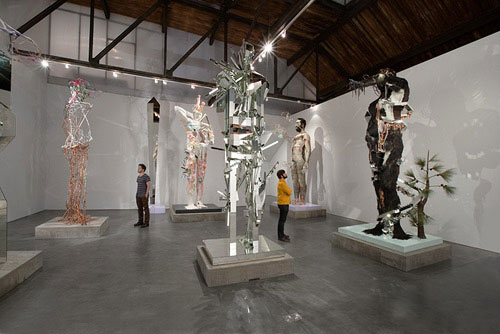
david altmejd’ installation view at andrea rosen gallery (may 3 - june 14, 2008)
©david altmejd (photo by tom powel)
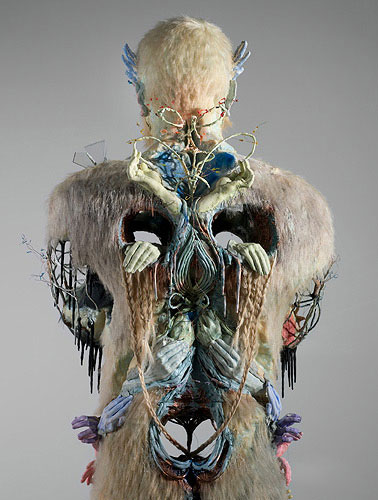
‘the center’, 2008 (mixed media)
©david altmejd (photo by ellen page wilson)
cast of characters
the unusual nature of altmejd’s work is perhaps one of
the key reasons behind his quick rise to prominence.
figures made from an assortment of plaster, morphed
mannequin parts, animal heads, crystals and birds are
his primary subject. he combines these things together
to create a fantastical world that plays with the
conventions of reality. a dying werewolf with mirrored
crystals spouting out of it and a giant’s head filled with
tiny rooms like a dollhouse are only some of the scenes
depicted in his artwork. his work thus occupies a niche
in the contemporary art world which is very much his own.
altmejd has stated that he explores a fantasy world in his
work because it serves as a device with which he can
put reality into perspective. for example, altmejd very
rarely chooses to portray human figures because he
believes they are over-explored in art. instead,
he depicts mythical creatures like werewolves and
giants. while surreal and fantastical, these figures still
have many human-like characteristics. this proximity
to reality allows viewers to relate to his characters,
but there is still enough of a difference to create a
weird tension.
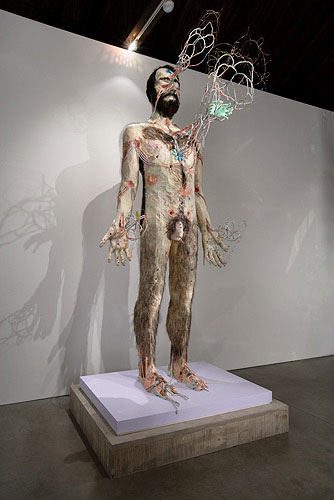
‘the spiderman’, 2008 (mixed media)
©david altmejd (photo by ellen page wilson)
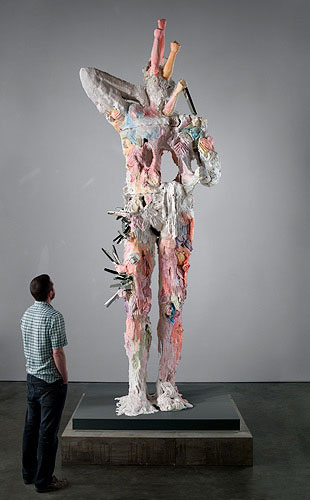
‘you’, 2008 (mixed media)
©david altmejd (photo by ellen page wilson)
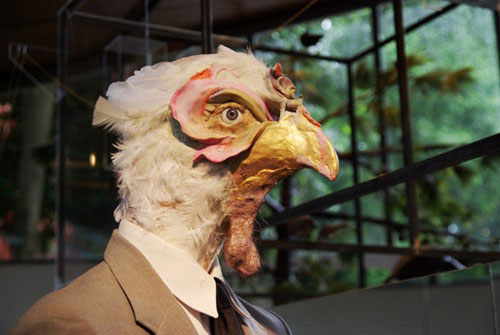
‘the index’, 2007 (mixed media) detail view at the canadian pavilion during the 52nd venice biennale
image © designboom
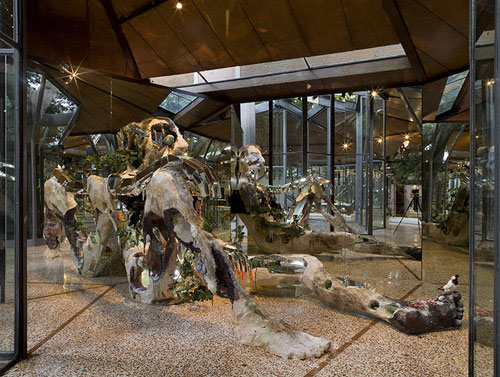
‘the giant 2’ 2007 (mixed media) installation view at the canadian pavilion during the 52nd venice biennale
©david altmejd (photo by ellen page wilson)
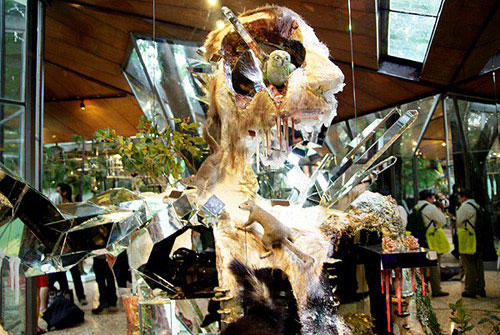
'the giant 2’ 2007 (mixed media) installation view at the canadian pavilion during the 52nd venice biennale
image © designboom
symbols and energy
while altmejd’s work has evolved over time, he maintains
a clear trajectory. despite variations among his individual projects,
his perspective and formal language is evident throughout.
but altmejd shies away from the suggestion
that his work has a language, instead he describes his
role in making his art more like a curator, combining
images and symbols that have ‘meaning potential’ to
create an energy. this energy, is what he believes fills
his art with meaning. as the viewer is presented with
his art, the symbols and their juxtapositions interact to
create an energy.
however, while the assortment of images and symbols
he selects would hint at an intentional subtext, the artist
focuses on undefined narratives. his choices are
intentional but the associated meanings are not,
he leaves this up to the viewer. unlike most contemporary
art, altmejd doesn’t encourage the viewer to decode
the artistic meaning behind his works. he creates work
with no intention of communicating a specific idea,
much to the chagrin of many critics searching for
meaning behind his art. for him, it is more important to
create something that is uncontrolled and unresolved.
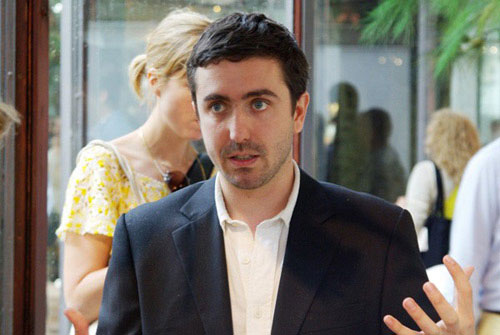
‘david altmejd speaks during the 52nd venice biennale
image © designboom
venice
after successful shows at a number of prestigious
galleries and renowned museums, altmejd’s career hit
its highest point when he was invited to represent
canada at the 2007 venice art biennale. with the eyes
of the art world on him, altmejd assembled a multi-faceted
installation he titled ‘the index’. this work proved to be
a culmination of his young career, resulting in an
expansive work that filled the canadian pavilion.
the installation featured two main sculptures, one that
features two platforms connected by a mirrored bridge
and a second which portrays a decomposing giant
sitting against the wall. the first piece is dotted with
small details like squirrels, birds, trees and flowers.
on top of the platforms stand life-size creatures with
human bodies and bird heads featuring testicles
hanging under their chins. one of the birdmen sits
inside a structure of mirrors while the other two stand
like suited fashion mannequins, one of which clutches
a decapitated werewolf head. the second sculpture is
a reclining giant, who sits on the ground leaning against
the wall. his body is in complete decay, with gapping
holes all over. inside these cavities, mirrored crystals,
mushrooms, birds and wildlife abounds.
more
‘the index’ at the 2007 venice biennale
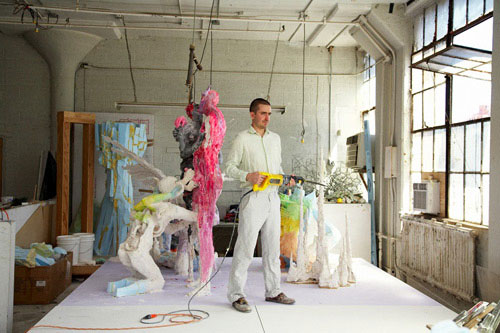
david altmejd in his studio (photo via the selby)
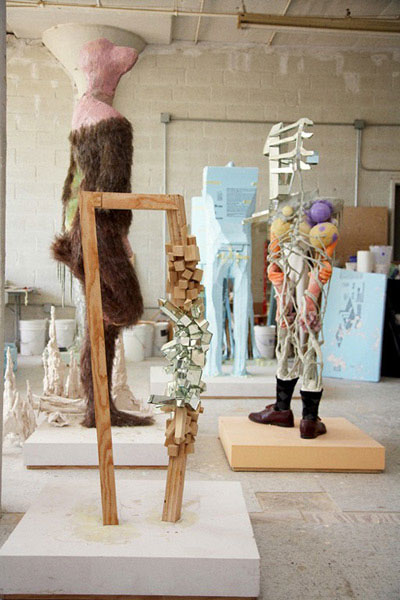
works in progress in david altmejd’s studio (photo via the selby)
new work
since his venice installation, interest in altmejd’s work
has grown immensely. he has continued to show his
work in galleries all over the world and expand his
creative vision. the latest phase of his oeuvre was
summed up in his most recent solo show at andrea
rosen gallery in mid-2008. the show featured a fresh
crop of fantastical characters, that unlike their
predecessors, didn’t stand on sprawling bases
covered in surreal landscapes. in these new works,
altmejd’s figures stand alone on simple flat plinths.
this evolution is a direct result of altmejd’s belief that
the body is a world of its own, ‘a total universe’.
rather than inhabiting the landscape of a fantasyland,
these characters are in themselves the landscape.
while altmejd approached these giants differently than
his previous works, they still contain his trademark
vocabulary. the first sculpture is entitled ‘the cave,
it is a tall tapped obelisk reflecting the giants around it.
‘you’ is a plaster giant covered in muted pastel tones
complete with mirror crystals and protruding fists.
it sits in between ‘figure’ a multi-coloured wire skeleton
and ‘the spiderman’ a human-like giant that has wire
fields emanating from its hands, chest and head.
the next row features two giants made completely
from geometric forms covered in mirror. one is solid
and rock –like while the other is delicate and fragmented.
‘the shepherd’ is the third giant in this row, he is covered
in dark hair and shielding his face with his arm.
crystals grow from his chest and feet, where a
staircase emerges winding around him. in the last
row, there are two abstract wire sculptures and
a cross-armed giant that is being ripped apart from
within. these statuesque works make clear references
to classical sculpture and renaissance masters.
but as always altmejd doesn’t have something to
present to viewers, he leaves the material to construct
meaning on its own.
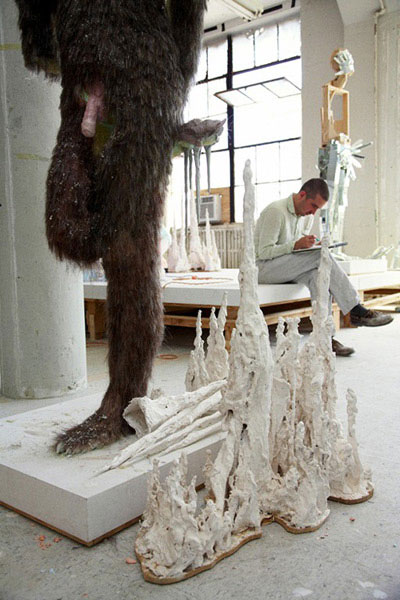
david altmejd in his studio (photo via the selby)
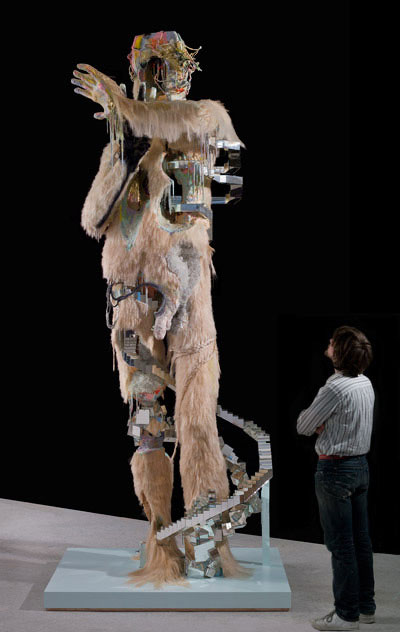
‘le berger’, 2008 (mixed media)
©david altmejd (photo by ellen page wilson)
about
david altmejd was born in montréal, canada in 1974.
he studied art at the université du québec à montréal,
graduating in 1998. he had his solo show debut this
same year, exhibiting in a number of montréal galleries.
he then moved to new york to pursue his masters of
fine art degree at columbia university. he continued
exhibiting his work back in montréal and graduated
in 2001. his work has since been shown in new york,
london and other cities around the world. in addition,
he has had his work exhibited in the 8th istanbul biennial
and the 2007 venice biennial, where he represented
canada. he now lives and works in queens, new york.
he is represented by stuart shave/modern art in
london and andrea rosen gallery in new york.
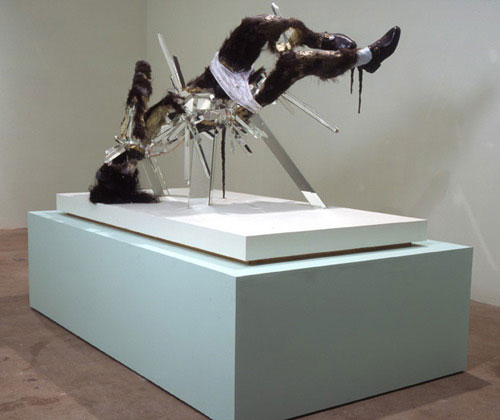
‘the glasswalker’, 2006
© david altmejd
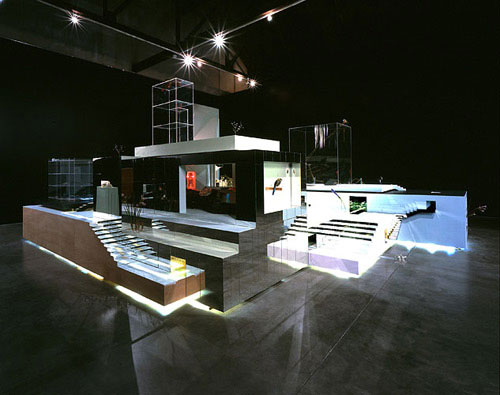
‘the university 2’, 2004 (mixed media) installation view at andrea rosen gallery
(october 22 - november 27, 2004)
© david altmejd (photo by oren slor)
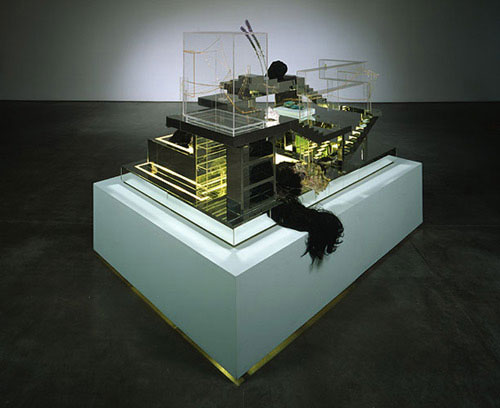
‘the outside, the inside, and the praying mantis’, 2005 (mixed media)
© david altmejd (photo by rob kassabian)
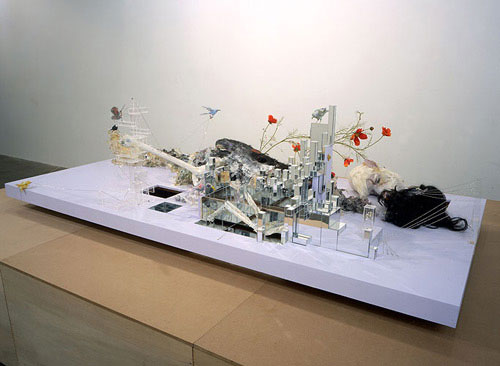
‘the old sculptor’, 2003 (mixed media)
© david altmejd (photo by adam reich)
- www.designboom.com/
‘david altmejd’ installation view at andrea rosen gallery (may 3 - june 14, 2008)
©david altmejd (photo by tom powel)
david altmejd burst onto the contemporary art scene
seemingly out of nowhere. the young sculptor began
exhibiting at small galleries in his hometown of
montréal and then made the move to new york.
since graduating with an mfa from columbia university
in 2001, he has participated in a number of high profile
shows in new york and abroad, including the 2003
istanbul biennial and the 2004 whitney biennial.
then, only 6 years after graduating, he was selected to
represent canada in the 2007 venice biennale. this made
him one of the youngest artists ever chosen to represent
their country in the prestigious exhibit.

david altmejd’ installation view at andrea rosen gallery (may 3 - june 14, 2008)
©david altmejd (photo by tom powel)

‘the center’, 2008 (mixed media)
©david altmejd (photo by ellen page wilson)
cast of characters
the unusual nature of altmejd’s work is perhaps one of
the key reasons behind his quick rise to prominence.
figures made from an assortment of plaster, morphed
mannequin parts, animal heads, crystals and birds are
his primary subject. he combines these things together
to create a fantastical world that plays with the
conventions of reality. a dying werewolf with mirrored
crystals spouting out of it and a giant’s head filled with
tiny rooms like a dollhouse are only some of the scenes
depicted in his artwork. his work thus occupies a niche
in the contemporary art world which is very much his own.
altmejd has stated that he explores a fantasy world in his
work because it serves as a device with which he can
put reality into perspective. for example, altmejd very
rarely chooses to portray human figures because he
believes they are over-explored in art. instead,
he depicts mythical creatures like werewolves and
giants. while surreal and fantastical, these figures still
have many human-like characteristics. this proximity
to reality allows viewers to relate to his characters,
but there is still enough of a difference to create a
weird tension.

‘the spiderman’, 2008 (mixed media)
©david altmejd (photo by ellen page wilson)

‘you’, 2008 (mixed media)
©david altmejd (photo by ellen page wilson)

‘the index’, 2007 (mixed media) detail view at the canadian pavilion during the 52nd venice biennale
image © designboom

‘the giant 2’ 2007 (mixed media) installation view at the canadian pavilion during the 52nd venice biennale
©david altmejd (photo by ellen page wilson)

'the giant 2’ 2007 (mixed media) installation view at the canadian pavilion during the 52nd venice biennale
image © designboom
symbols and energy
while altmejd’s work has evolved over time, he maintains
a clear trajectory. despite variations among his individual projects,
his perspective and formal language is evident throughout.
but altmejd shies away from the suggestion
that his work has a language, instead he describes his
role in making his art more like a curator, combining
images and symbols that have ‘meaning potential’ to
create an energy. this energy, is what he believes fills
his art with meaning. as the viewer is presented with
his art, the symbols and their juxtapositions interact to
create an energy.
however, while the assortment of images and symbols
he selects would hint at an intentional subtext, the artist
focuses on undefined narratives. his choices are
intentional but the associated meanings are not,
he leaves this up to the viewer. unlike most contemporary
art, altmejd doesn’t encourage the viewer to decode
the artistic meaning behind his works. he creates work
with no intention of communicating a specific idea,
much to the chagrin of many critics searching for
meaning behind his art. for him, it is more important to
create something that is uncontrolled and unresolved.

‘david altmejd speaks during the 52nd venice biennale
image © designboom
venice
after successful shows at a number of prestigious
galleries and renowned museums, altmejd’s career hit
its highest point when he was invited to represent
canada at the 2007 venice art biennale. with the eyes
of the art world on him, altmejd assembled a multi-faceted
installation he titled ‘the index’. this work proved to be
a culmination of his young career, resulting in an
expansive work that filled the canadian pavilion.
the installation featured two main sculptures, one that
features two platforms connected by a mirrored bridge
and a second which portrays a decomposing giant
sitting against the wall. the first piece is dotted with
small details like squirrels, birds, trees and flowers.
on top of the platforms stand life-size creatures with
human bodies and bird heads featuring testicles
hanging under their chins. one of the birdmen sits
inside a structure of mirrors while the other two stand
like suited fashion mannequins, one of which clutches
a decapitated werewolf head. the second sculpture is
a reclining giant, who sits on the ground leaning against
the wall. his body is in complete decay, with gapping
holes all over. inside these cavities, mirrored crystals,
mushrooms, birds and wildlife abounds.
more
‘the index’ at the 2007 venice biennale

david altmejd in his studio (photo via the selby)

works in progress in david altmejd’s studio (photo via the selby)
new work
since his venice installation, interest in altmejd’s work
has grown immensely. he has continued to show his
work in galleries all over the world and expand his
creative vision. the latest phase of his oeuvre was
summed up in his most recent solo show at andrea
rosen gallery in mid-2008. the show featured a fresh
crop of fantastical characters, that unlike their
predecessors, didn’t stand on sprawling bases
covered in surreal landscapes. in these new works,
altmejd’s figures stand alone on simple flat plinths.
this evolution is a direct result of altmejd’s belief that
the body is a world of its own, ‘a total universe’.
rather than inhabiting the landscape of a fantasyland,
these characters are in themselves the landscape.
while altmejd approached these giants differently than
his previous works, they still contain his trademark
vocabulary. the first sculpture is entitled ‘the cave,
it is a tall tapped obelisk reflecting the giants around it.
‘you’ is a plaster giant covered in muted pastel tones
complete with mirror crystals and protruding fists.
it sits in between ‘figure’ a multi-coloured wire skeleton
and ‘the spiderman’ a human-like giant that has wire
fields emanating from its hands, chest and head.
the next row features two giants made completely
from geometric forms covered in mirror. one is solid
and rock –like while the other is delicate and fragmented.
‘the shepherd’ is the third giant in this row, he is covered
in dark hair and shielding his face with his arm.
crystals grow from his chest and feet, where a
staircase emerges winding around him. in the last
row, there are two abstract wire sculptures and
a cross-armed giant that is being ripped apart from
within. these statuesque works make clear references
to classical sculpture and renaissance masters.
but as always altmejd doesn’t have something to
present to viewers, he leaves the material to construct
meaning on its own.

david altmejd in his studio (photo via the selby)

‘le berger’, 2008 (mixed media)
©david altmejd (photo by ellen page wilson)
about
david altmejd was born in montréal, canada in 1974.
he studied art at the université du québec à montréal,
graduating in 1998. he had his solo show debut this
same year, exhibiting in a number of montréal galleries.
he then moved to new york to pursue his masters of
fine art degree at columbia university. he continued
exhibiting his work back in montréal and graduated
in 2001. his work has since been shown in new york,
london and other cities around the world. in addition,
he has had his work exhibited in the 8th istanbul biennial
and the 2007 venice biennial, where he represented
canada. he now lives and works in queens, new york.
he is represented by stuart shave/modern art in
london and andrea rosen gallery in new york.

‘the glasswalker’, 2006
© david altmejd

‘the university 2’, 2004 (mixed media) installation view at andrea rosen gallery
(october 22 - november 27, 2004)
© david altmejd (photo by oren slor)

‘the outside, the inside, and the praying mantis’, 2005 (mixed media)
© david altmejd (photo by rob kassabian)

‘the old sculptor’, 2003 (mixed media)
© david altmejd (photo by adam reich)
- www.designboom.com/
links
andrea rosen gallery
http://www.andrearosengallery.com
stuart shave / modern art
http://www.modernart.net

These Plexiglas structures contain entire landscapes that are immensely and painstakingly detailed. Their scale and composition both encourage a close reading of details and yet purposefully disallow the viewer to grasp the whole all at once. For the first time, Altmejd will intervene into the architecture of the space with large scale sculptures scraped out of and embedded within the walls of the gallery. Just as the Plexiglas works represent a material shift from the exterior surface to the interior structure, between the inside and the outside, the embedded plaster sculptures turn space itself into an analogue of Altmejd’s investigation into notions of interiority and exteriority in his practice. As definitions between inside and outside become blurred, Altmejd shows them at once to be both malleable distinctions and part of a continuum.
At stake in these works is the fantasy of unity and containment. Just as Altmejd has shown how bodies can be so violently acted upon by interior and exterior forces, in his work the apparent neutrality and solidity of architecture is shown to be unable to contain the overflow of ideologies and agendas embedded within—the body of the space bursting and the walls becoming a porous membrane.
Altmejd’s work makes evident how growth and transformation is only possible from decay and how a sense of a work being alive is perceived most fully when beauty is contrasted with the abject. Set against a prevailing cultural and political headwind valuing tradition, certainty, and stasis, Altmejd’s work is a physical manifestation of an ideology of growth, change, and perpetual movement.
Altmejd’s work makes evident how growth and transformation is only possible from decay and how a sense of a work being alive is perceived most fully when beauty is contrasted with the abject. Set against a prevailing cultural and political headwind valuing tradition, certainty, and stasis, Altmejd’s work is a physical manifestation of an ideology of growth, change, and perpetual movement.
In Altmejd’s work, chaos and order are shown to be two related states that can generate each other. In one Plexiglas work titled The Vessel 2011, plaster casts of arms and hands form swanlike shapes, with the hands holding (or throwing) beaks formed from modeling clay. The hands collectively take on the shape of a cresting wave and embody the latent potential of that form as though tension is held in a perpetual climax. The line between violence and protection becomes blurred, as does our desire for one over the other.
Seen from the front, the composition appears nearly symmetrical, but upon closer inspection each side has been crafted individually with the symmetry of the structure becoming displaced by the subjectivity of individual choices. Conversely, Whether Altmejd begins from a point of symmetry or from a point of disorder, his works are ultimately shaped by the individual choices made at each point of construction. These works suggest the organic logic of the crowd where individual decisions can collectively generate a more intelligent whole.
Altmejd’s works suggest a kind of infinite lineage with each work both exploring a particular idea and contributing to the opening of another. Rather than creating terminal artworks, complete and ossified, Altmejd’s works are manifestations of objects that are always transforming and forever open. Rather than crafting puzzles for viewers to solve, Altmejd generates structures and landscapes to inhabit. - missmementomori.com/
Altmejd’s works suggest a kind of infinite lineage with each work both exploring a particular idea and contributing to the opening of another. Rather than creating terminal artworks, complete and ossified, Altmejd’s works are manifestations of objects that are always transforming and forever open. Rather than crafting puzzles for viewers to solve, Altmejd generates structures and landscapes to inhabit. - missmementomori.com/


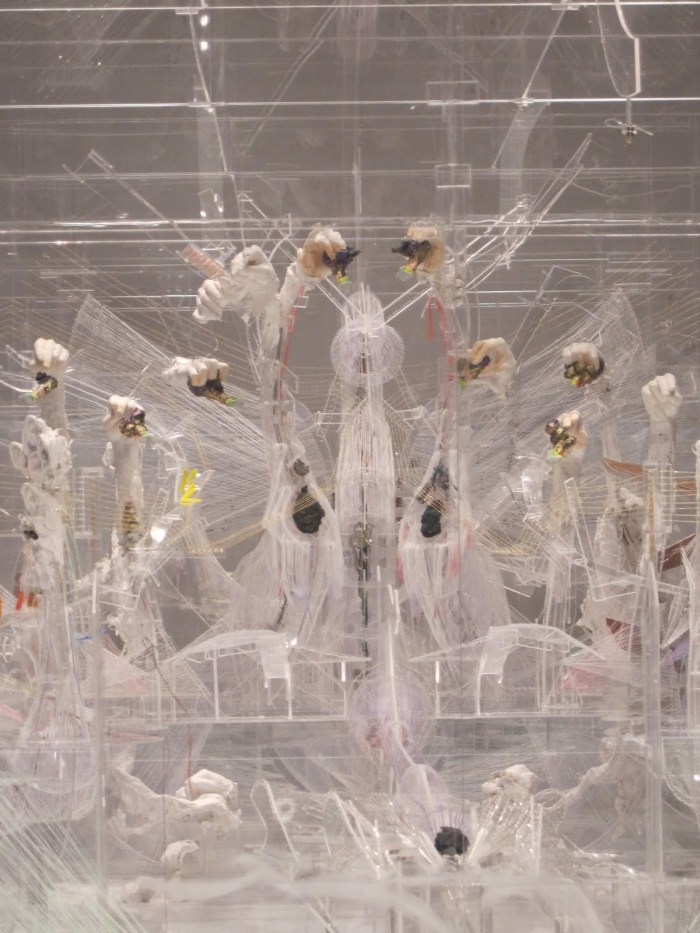


Nema komentara:
Objavi komentar